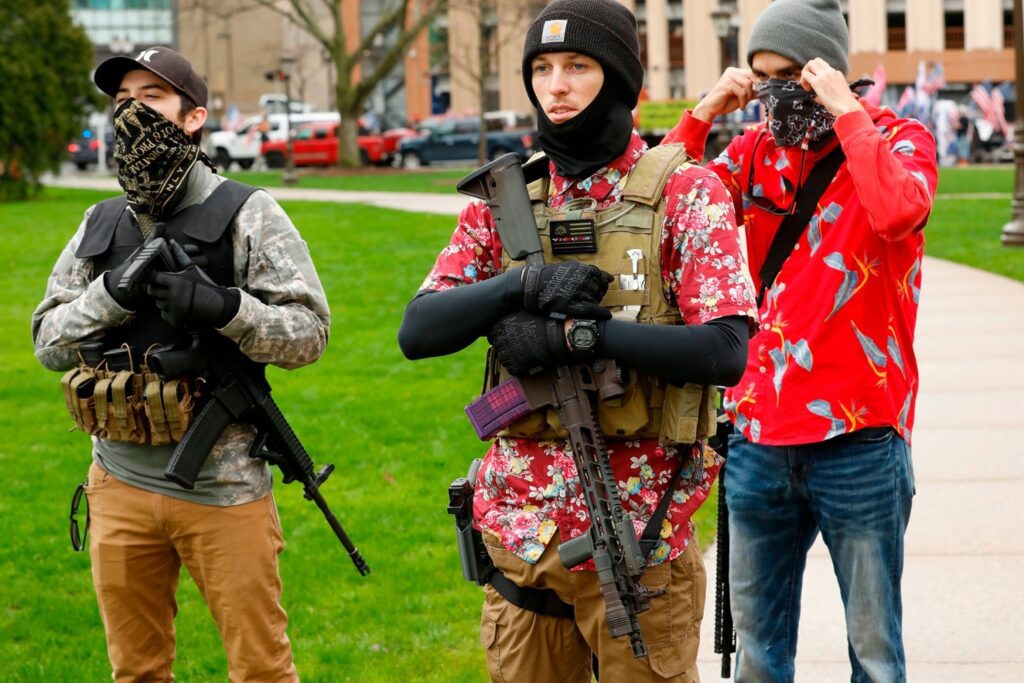Three men with military backgrounds have been arrested and charged with conspiracy to instigate violence at the Las Vegas protests against the death of George Floyd.
According to authorities, Andrew Lynam Jr., 23, Stephen Parshall, 35, and William Loomis, 40, all met at an anti-lockdown protest in April and self-identified as “boogaloo” boys, a term used to describe those calling for a violent civil conflict. They were arrested on Saturday on their way to a protest in downtown Las Vegas, after filling gas cans and making Molotov cocktails in glass bottles. They face federal charges of conspiracy to damage and destroy by fire and explosives, and possession of unregistered firearms. They are currently each being held on $1 million bond, according to the Star Tribune. They have not yet entered a plea.
Their intention was “to hopefully create civil unrest and rioting throughout Las Vegas,” a complaint filed in Las Vegas District Court on Wednesday said. (Rolling Stone reached out to the three men on Facebook for comment, and have yet to hear back.)
“Boogaloo” has been referred to as an anti-government movement, but it’s not a movement or organization or even a cohesive ideology so much as a meme. “They’re right-leaning and they love their guns,” says Megan Squire, professor of computer science at Elon University, who studies white supremacists and extremists online. “That’s really the extent of a uniting principle.”
The term originated on /k/, a 4chan forum for weapons enthusiasts with notable far-right leanings, and stems from the title of the 1984 sequel Breakin’ 2: Electric Boogaloo (generic internet speak for a sequel). It evolved into slang terminology for an impending revolution, or a second Civil War. “They kind of took what was a popular internet meme calling things a sequel and they put an extremist slant on it by talking about it in the context of a coming civil conflict,” says Howard Graves, senior research analyst at the Southern Poverty Law Center.
The fact that it originated in mainstream meme culture also provides a convenient cover for those who use it to argue that its function is purely innocuous, a common tactic among the far right, even though much of their rhetoric is overtly violent and racist. (Although many boogaloo boys deny the latter, it’s particularly salient given the term’s roots as a dance and musical subgenre in black and brown communities). Like many other memes used by the far right, the term boogaloo and its accompanying iconography, such as their predilection for Hawaiian shirts (a play on the term “big luau,” or code for boogaloo) can be cited as evidence that it’s all just an ironic joke not to be taken seriously, which masks the earnestness behind their aims. “While many still use the boogaloo meme jokingly, an increasing number of people employ the phrase to incite an apocalyptic confrontation with law enforcement and government officials or to provoke ethnic warfare,” the authors of a report from the National Contagion Research Institute (NCRI) wrote earlier this year.
“They’re presenting themselves as very libertarian, second amendment types,” says Squire. But the community has also led to numerous calls to violence: In April, for instance, 36-year-old Aaron Swenson was arrested in Arkansas after threatening to murder police officers on Facebook Live.
In recent months, so-called “boogaloo” boys (or bois) started popping up at actions such as the Richmond gun rally back in January. The vast majority are white men in their 20s and 30s, many of whom are ex-military, like two of the men arrested in Nevada, says Squire.

Armed protesters at a Michigan “American Patriot Rally,” on April 30th, display Hawaiian shirts, an item associated with boogaloo boys.
Jeff Kowalsky/AFP/Getty Images
But the COVID-19 pandemic and subsequent lockdown spurred many of them to action, with some showing up at anti-lockdown protests to protect small business owners defying lockdown against police officers. Many of them wore Hawaiian shirts and toted automatic weapons. During the police brutality protests, many self-identified boogaloo boys have shown up at rallies armed. As a reflection of their fragmented ideology, some explicitly align with the protesters, while others, particularly those increasingly migrating from other extremist groups, embrace white supremacy.
“A lot of folks have been contacting us trying to figure out whether boogaloo boys or white supremacists are ‘infiltrating’ protests and trying to turn these into riots, and we have not seen evidence of that,” says Graves. “But this shows extremists see this as an opportunity they can take advantage of and escalate conflict… they are there to instigate a conflict with people off the backs of people with legitimate grievances against police brutality.”
The arrests of the three men in Nevada take place on the heels of increasingly heated right-wing media rhetoric targeted at anti-police brutality protesters, much of which has been propagated by President Donald Trump, who has blamed the violence at protests on “Antifa” and has threatened to designate them as a terrorist group. At the time of this writing, Trump has made no mention of the arrests of the Nevada men.
“There’s this idea the violence has to be incited from somewhere else and it has to be these radical groups on ‘both sides,’” says Graves. “I have not seen evidence of infiltration into the protests on the other side, but I am certainly aware of the far-right trying to leverage these events and cause mass chaos.”
